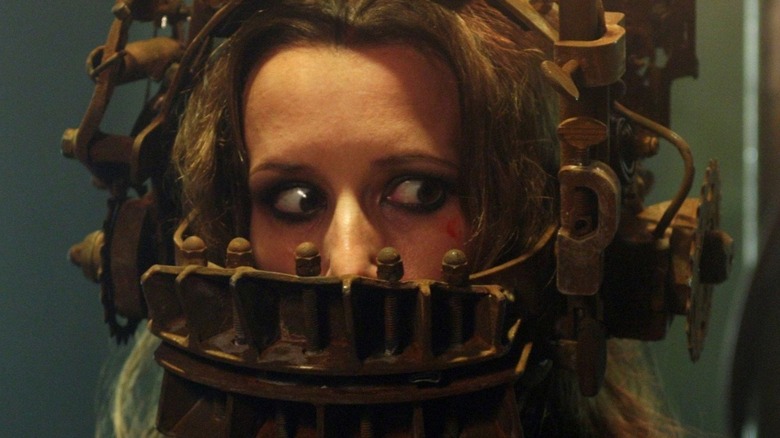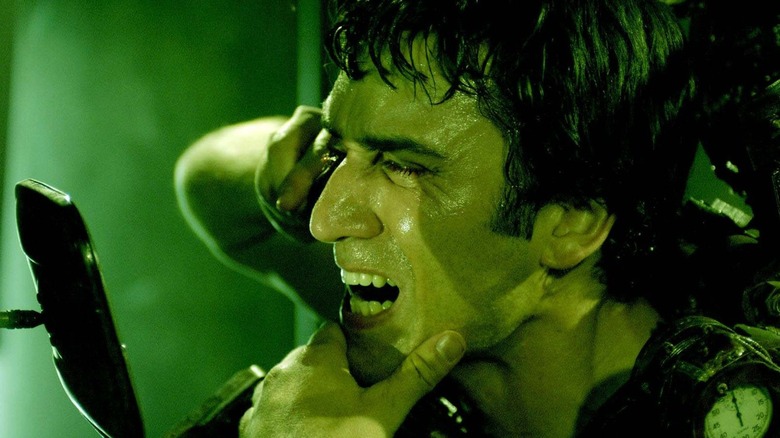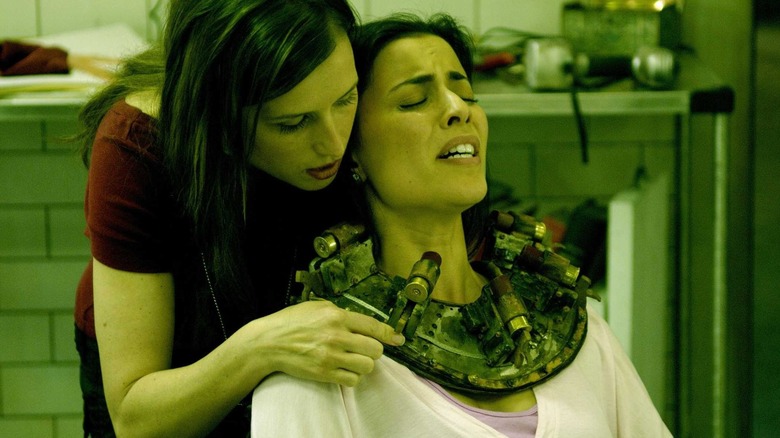How Saw's Composer Manipulates The Music To Drag Audiences Into A 'Dismal Pit' [Exclusive]
As a whole, the "Saw" movies are dark morality fables for the post-9/11 world. They follow a former machinist named John Kramer (Tobin Bell), a.k.a. Jigsaw, as he kidnaps his victims and locks them into outsized metal death traps outfitted with some sort of time-release widget. His victims are given the means to escape the death traps, but it typically involves doing grievous bodily harm to one's self ... or to someone else. In the picture above, Shawnee Smith can remove the bear trap-like device locked onto her head if she retrieves the key from inside the stomach of the still-living man lying next to her. Naturally, things get messy.
The gimmick of the "Saw" movies is that the victims who escape often claim to have a strange catharsis. Having faced a specifically organized death, and having made a palpable, measurable decision to save their own lives, they tend to turn over a new leaf. Or, in many cases, join Jigsaw in his quest to provide justice for the unjust people of the world. The whole "Saw" series details the rise of a pyramid scheme formed after the failure of the medical insurance system.
Naturally, such a bloody and complicated film series would require a recognizable theme song that would evoke horror and catharsis at the same time. Composer Charlie Clouser has written the music for all ten of the extant "Saw" movies to date, and his plinking, semi-industrial '00s MTV aural vibe has come to define an entire generation of horror movies. Talking to /Film's own Ryan Scott, Closuer revealed the philosophy of his "Saw" compositions and how he used certain sounds — and ideas — to drag the audience into despair.
Sonic molecules
Clouser has also scored numerous other films and TV shows, including writing the theme song for "American Horror Story" and the scores for films like "Dead Silence" and "The Collection." Most of his projects to date have been horror-adjacent, but it's the "Saw" movies that have their own unique sound. He said:
"There are some elements in the score for all of the 'Saw' movies that I subconsciously feel ... have to be there. Whether it's a particular sound, like the sound of a violin bow on this bow-metal instrument that I have, or whatever. So there are some sonic molecules that I always feel can only be used in a 'Saw' movie that I don't use anywhere else, in any other type of scoring project."
Clouser added that each character throughout the series has their own subtle theme worked into the score at large. He also noted that every film contains the now-famous "Hello Zepp" theme, the tune that has come to define the sound of all ten "Saw" movies to date.
But there is a philosophy to "Saw" composing that Clouser has adhered to as a matter of course. Just as the characters are being dragged into filthy, horrifying places of death and mutilation, so too does the chord progression drag downward. Clouser stated it thus:
"There are other more philosophical musical approaches that I always use in 'Saw' movies. For instance, one tendency I have is that all the chord progressions and where the root node is, where your left hand is on the keyboard, is always moving downwards and never upwards so that it sounds like the music is always transposing down, and dragging the characters and the audience down into some dismal pit."
Indeed.
The philosophy of downward progression
The downward progression, Clouser said, was logical to him. Upward and downward movements in the music, he said, merely follow the overall mood of the films. As characters feel horror and fear, the music drags them — and the audience — into lower and lower notes. Once they escape and a bleak catharsis sets in, the notes begin getting higher and higher. It seems simple, and yet it has proven to be effective time and time again. Clouser said:
"I do that just because it seems to make philosophical sense. But the side effect of that is that it allows for a huge contrast in those two or three moments when I then reverse direction and begin moving upwards across the scale. That can have the effect of making those moments much more impactful because we've been waist deep in the murk that's always moving downwards and things are just getting lower and lower in pitch throughout the entire score until, at some point ... a switch gets flipped and the music starts moving upwards and it creates a very marked contrast."
Clouser also notes that the scores for the "Saw" movies are more "hummable" than many other horror scores. Most horror movies tend to have the same kinds of plaintive violins or booming jump-scare sounds without providing a memorable theme. Clouser's "up and down" philosophy, he said, gives "Saw" more actual melody. He said:
"Those kinds of little philosophical game plans really help to shape the overall arc of the scores of most of the movies. I would also like to think they help to make those scores sound a little different to maybe more thematic and melodically-oriented horror scores in other films."
"Saw X" is due in theaters on September 29, 2023.


